 |
 |
Our enthusiastic and extremely knowledgeable perennials team is here to answer your questions and help you choose the best perennials for your situation. There’s always something in bloom for sun, shade, butterflies, birds or deer resistance as well as a variety of bulbs for your space.
Stroll through our time-tested favorites and introduce yourself to the newest varieties. We garden with perennials too; we love them and it shows!
|
28 found, showing page 1 of 2
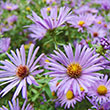
Height: 24 inches
Spread: 24 inches
Sunlight: full sun partial shade
Hardiness Zone: 4a
Other Names: Michaelmas Daisy
Description:
This vigorous native selection forms a nice clump, smothered with beautiful, daisy-like, violet-blue flowers with yellow centers in fall; puts on an amazing show even on hot, dry sites; needs sun and good drainage for best flowering
Ornamental Features:
Raydon's Favorite Aster has masses of beautiful violet daisy flowers with blue overtones and yellow eyes at the ends of the stems from early to late fall, which are most effective when planted in groupings. The flowers are excellent for cutting. Its narrow leaves remain dark green in color throughout the season.
Landscape Attributes:
Raydon's Favorite Aster is a dense herbaceous perennial with a mounded form. Its relatively fine texture sets it apart from other garden plants with less refined foliage.
This is a relatively low maintenance plant, and is best cleaned up in early spring before it resumes active growth for the season. It is a good choice for attracting bees and butterflies to your yard, but is not particularly attractive to deer who tend to leave it alone in favor of tastier treats. Gardeners should be aware of the following characteristic(s) that may warrant special consideration: Disease
Raydon's Favorite Aster is recommended for the following landscape applications:
- Mass Planting
- General Garden Use
- Groundcover
- Container Planting
Planting & Growing:
Raydon's Favorite Aster will grow to be about 24 inches tall at maturity, with a spread of 24 inches. Its foliage tends to remain dense right to the ground, not requiring facer plants in front. It grows at a medium rate, and under ideal conditions can be expected to live for approximately 10 years. As an herbaceous perennial, this plant will usually die back to the crown each winter, and will regrow from the base each spring. Be careful not to disturb the crown in late winter when it may not be readily seen!
This plant does best in full sun to partial shade. It prefers to grow in average to moist conditions, and shouldn't be allowed to dry out. It is not particular as to soil type or pH. It is somewhat tolerant of urban pollution. This is a selection of a native North American species. It can be propagated by division; however, as a cultivated variety, be aware that it may be subject to certain restrictions or prohibitions on propagation.
Raydon's Favorite Aster is a fine choice for the garden, but it is also a good selection for planting in outdoor pots and containers. It can be used either as 'filler' or as a 'thriller' in the 'spiller-thriller-filler' container combination, depending on the height and form of the other plants used in the container planting. It is even sizeable enough that it can be grown alone in a suitable container. Note that when growing plants in outdoor containers and baskets, they may require more frequent waterings than they would in the yard or garden.
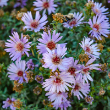
Height: 12 inches
Spread: 18 inches
Sunlight: full sun, partial shade
Hardiness Zone: 3a
Other Names: Michaelmas Daisy
Description:
Mounds of narrow, dark green foliage are covered with sky-blue daisy-like flowers, adding a pop of color to autumn days; dwarf compact habit, ideal for patio containers, borders or garden beds; beautiful added to fresh cut arrangements; low maintenance
Ornamental Features:
Woods Blue Aster has masses of beautiful sky blue daisy flowers with yellow eyes at the ends of the stems from early to late fall, which are most effective when planted in groupings. The flowers are excellent for cutting. Its narrow leaves remain dark green in color throughout the season.
Landscape Attributes:
Woods Blue Aster is a dense herbaceous perennial with a mounded form. Its relatively fine texture sets it apart from other garden plants with less refined foliage.
This is a relatively low maintenance plant, and is best cleaned up in early spring before it resumes active growth for the season. It is a good choice for attracting butterflies to your yard, but is not particularly attractive to deer who tend to leave it alone in favor of tastier treats. Gardeners should be aware of the following characteristic(s) that may warrant special consideration;
-Disease
Woods Blue Aster is recommended for the following landscape applications:
- Mass Planting
- General Garden Use
- Container Planting
- Planting & Growing
Woods Blue Aster will grow to be about 12 inches tall at maturity, with a spread of 18 inches. Its foliage tends to remain dense right to the ground, not requiring facer plants in front. It grows at a medium rate, and under ideal conditions can be expected to live for approximately 10 years. As an herbaceous perennial, this plant will usually die back to the crown each winter, and will regrow from the base each spring. Be careful not to disturb the crown in late winter when it may not be readily seen!
This plant does best in full sun to partial shade. It prefers to grow in average to moist conditions, and shouldn't be allowed to dry out. It is not particular as to soil type or pH. It is somewhat tolerant of urban pollution. This particular variety is an interspecific hybrid. It can be propagated by division; however, as a cultivated variety, be aware that it may be subject to certain restrictions or prohibitions on propagation.
Woods Blue Aster is a fine choice for the garden, but it is also a good selection for planting in outdoor pots and containers. It is often used as a 'filler' in the 'spiller-thriller-filler' container combination, providing a mass of flowers against which the thriller plants stand out. Note that when growing plants in outdoor containers and baskets, they may require more frequent waterings than they would in the yard or garden.
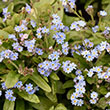
Small, blue flowers bloom in abundance. Dense, mounded habit. USDA 3-9

Attractive verigated grass-like foliage and large, spectacular pale blue blooms. USDA 4-9
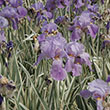
Pale blue blooms. Fragrant. Cream & green variegated foliage. USDA 4-9

Vibrant blue blooms. Compact, clumping foliage. USDA 4-9
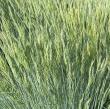
Blue foliage. Clumping. Heat tolerant. Semi-evergreen. USDA 4-8
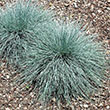
Intense blue foliage. Non-fading. Semi-evergreen. USDA 4-9
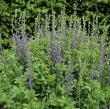
Blue Blooms. Shruby. Tolerates deer, drought, & poor soils. USDA 3-9

Heat and humidity tolerant, mounding habit, and periwinkle blue blooms appearing late spring. Near-Black Stems. USDA 4-9
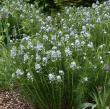
Long-lived plant with clusters of blue flowers in May and June and golden fall color on an upright, bushy plant. USDA 5-8
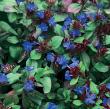
Deep blue flowers. In early fall, leaves change to a vivid mahogany red color. Growing in sun or shade. Wide range of soil types. Long-lived groundcover. USDA 5-9
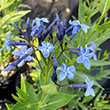
Native clump-forming slow speading groundcover. Blue spring flowers, feathery green summer foliage, and golden fall color. USDA 5-9
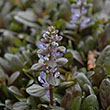
Naturalizing groundcover with short spikes of blue flowers on chocolate-colored foliage with burgundy highlights. USDA 3-9.
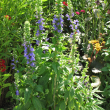
Tall spikes of blue blooms. Tolerates moist to wet soils. Native. USDA 4-9
28 found, showing page 1 of 2










